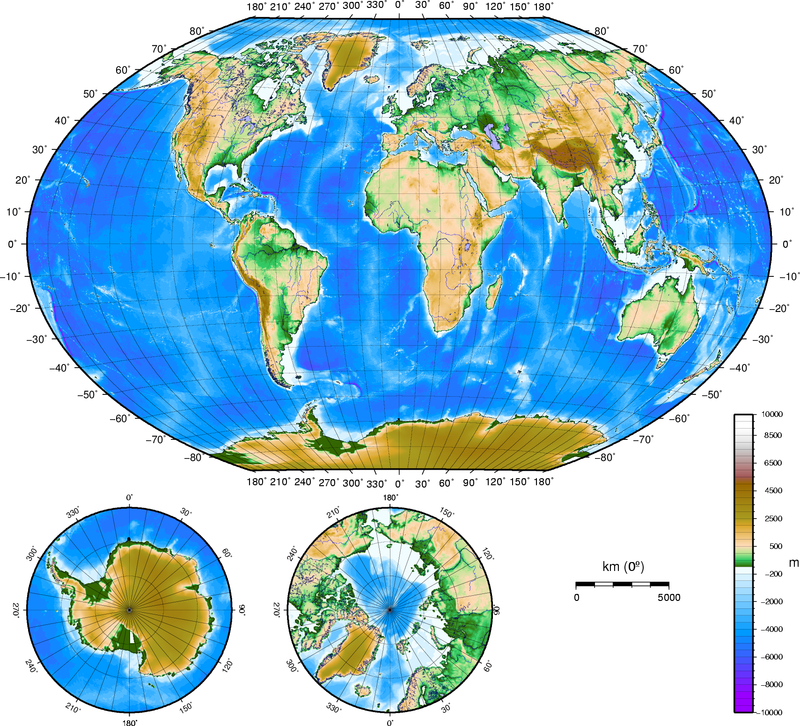Geography ; World Maps

A geographic chart is a scaled-down, generalized image of the surface of the Earth, another celestial body, or extraterrestrial space constructed in a cartographic projection, showing objects or phenomena located on it in a certain system of conventional signs.
A map is a mathematically defined figurative-symbolic model of reality.
Geographical maps are classified by content, scale, purpose, territorial characteristic. According to the content, all maps are divided into general geographical and thematic.
The creation of cartographic works is engaged in the section of cartography - map science.
The creation of maps is carried out using cartographic projections - a way of transition from a real, geometrically complex earth surface to the plane of the map. To do this, first proceed to a mathematically correct figure of an ellipsoid or bullet, and then project the image onto a plane using mathematical dependencies. In this case, various auxiliary surfaces are used: cylinder, cone, plane. At the same time, the location of the cardinal points has now become almost the standard: north from above and, respectively, south below, west from the left and east from the right, relative to the beholder.
Cylindrical projections are used for maps of the world - a model of the Earth is mentally placed in a cylinder and the earth's surface is projected on its walls. When the cylinder is unfolded, a flat image is formed. The parallels and meridians in this projection correspond to straight lines drawn at an angle. In cylindrical design, the line of least distortion is the equator.
Conical projections are often used to depict Eurasia, Asia, and the world. To create this projection, one or more cones are mentally implanted on the model of the Earth and all points of the earth's surface are transferred to them. The meridians in this projection are straight lines coming out of one point (pole), and the parallels are the arcs of concentric circles.
For the image on the maps of individual continents and oceans, an azimuthal projection is used, in which the surface of the continent is projected onto the plane. The point of zero distortion is the point of contact of the plane to the earth's surface, the peripheral parts of the map have the maximum distortion. Parallels in straight azimuthal projections (the point of contact is the poles) are represented by concentric circles, and the meridians are represented by straight lines (rays). In the azimuthal projection, maps of Antarctica and the circumpolar regions have been compiled. In the transverse-azimuthal projection (the point of contact is at the equator), a map of the hemispheres is compiled, in which the meridians and parallels correspond to curves, with the exception of the equator and the middle meridians of the hemispheres. To depict individual continents, points of contact are chosen in their center (maps of Africa, Australia and America). In modern conditions, cartographic projections are also built using mathematical calculations without auxiliary surfaces; they are called conditional projections.
On any geographical maps there are distortions of lengths, angles, shapes and areas. These distortions are of different types, and their magnitude depends on the type of projection, the scale of the map and the coverage of the projected territory. You can detect length distortion along the meridians on the map by comparing the meridian segments between two adjacent parallels - if they are at the same level, then there is no length distortion. The distortion of distances on parallels is evidenced by the ratio of the lengths of the equator segments and the parallel of the 60° latitude between neighboring meridians. If there is no distortion, then the segment of the equator is exactly twice as large as the segment of the 60° parallel.
The distortion of angles characteristic of most maps can be concluded in the case when parallels and meridians do not form right angles between themselves.
You can distinguish between shape distortions by comparing the length and width of a geographical object on a map and a globe - if the ratios of shapes are proportional, then there is no distortion according to this criterion. It is even easier to distinguish the distortions of the shape by comparing the grid cells at the same latitude: if they are the same, then this indicates the absence of distortions of the shape on this geographical map.
Depending on the purpose of the maps, such projections are selected for them, on which one of the types of distortion may be absent, or be negligible. According to the nature of the distortions, cartographic projections are divided into
equal - there is no distortion of the area;
equiangular — no distortion of corners;
arbitrary - there are all kinds of distortions.
- Arts
- Business
- Computers
- Jocuri
- Health
- Home
- Kids and Teens
- Money
- News
- Recreation
- Reference
- Regional
- Science
- Shopping
- Society
- Sports
- Бизнес
- Деньги
- Дом
- Досуг
- Здоровье
- Игры
- Искусство
- Источники информации
- Компьютеры
- Наука
- Новости и СМИ
- Общество
- Покупки
- Спорт
- Страны и регионы
- World


